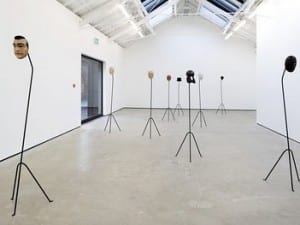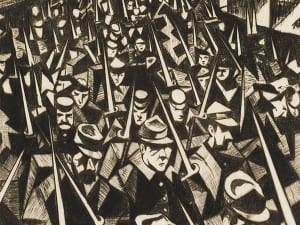When an important, popular figure dies, fans seem to need more than their legacy – more than their work – to remember them by, to cling to them through. Physical mementoes, objects – things which that specific person touched, used, loved – are obsessed over; particles of skin and saliva on a napkin George Harrison used take on strange importance. Voyeurism and celebrity obsession have grown to a point now where people are paying up to $15,000 for a pair of stained underpants worn by Elvis Presley, a rumoured million for a pair of John Lennon’s glasses, and, perhaps most bizarrely, $45,000 for a set of three X-rays of Marilyn Monroe’s chest. However, this strange obsession we seem to have with the physical remnants left in the wake of our popular icons can be traced back a surprisingly long way. Darwin’s beard, for example, Abraham Lincoln’s hair and even Galileo’s finger have survived decomposition and remain, today, preserved behind glass for us all to gawk at.
David Bowie Is, an exhibition at the V&A tracking Bowie’s career and life through a dazzling array of costumes, props, letters, videos etc, is no exception when it comes to this strange morbid fascination we have with objects that have touched fame, touched the very particles of celebrity (leaving behind skin, sweat and all). However, what is to note about this exhibition of Bowie’s impressive legacy (following on from typically similar exhibitions on Lennon, Sinatra and Queen), is that David Bowie, despite being described as a “Universal Spirit” in the exhibition catalogue and compared to the Archangel Gabriel by Lindsay Kemp, is not dead. In fact, having just released a new album, The Next Day, it is safe to say that he is very much alive.
A few things come to mind when moving through this exhibition. Obituary (or memorial) is one of them. One exhibit of a body suit from Bowie’s Ziggy Stardust tour is laid out, horizontal, and filled by a mannequin with a plastic Bowie face, in a coffin-sized, glass-topped case. People queue up to peer inside… Ziggy’s open casket. Other elements throughout – life-size representations of a Soho flat he lived in, a recording studio, everyday Bowie objects for everyday Bowie life (including a tissue stained with his lipstick) – seem tainted by the undeniable truth of Bowie’s mortality; all of these objects, all of these constructed spaces, place the icon in a strange, post-mortem, museum setting (similar to the preserved house of the Bronte sisters or of Dickens). It is as though, through obsessive Bowie mania, people are preparing for his death by draping themselves and their attention across his possessions and costumes (the things that we can depend on staying in this world forever).
Halfway through the exhibition, a group of about eight people crowd around one exhibit, craning their necks, aiming their flashing cameras over each other’s heads. “Can you believe it?” one of them says. “He actually wore those… his feet touched that leather!”… The woman is blushing red. The man next to her, with slicked back red hair (strangely Bowie-like) is smiling through the glass. The responses and reactions from some of the viewers make the exhibition seem like holy ground for some sort of Bowie Cult (they are the Bowie worshippers and the V&A, for the next few months, is their church). In one room, gigantic screens the size of building facades, play videos of Bowie in concert, blown-up so he appears like a giant, his head the height of a bus. Beneath, in a darkened pit-like area, visitors sit on the floor gaping up as he sings with his arms outstretched as if in crucifixion. All around too, on tall podiums, are Bowie mannequins, spot lit in glistening costumes, again with arms outstretched. In this room, people seem to only whisper. It feels like a shrine. “This is heaven,” a middle-aged lady says to her partner. Following on from this, the wall in a different, nearby room reads “David Bowie is all around you,” further cementing his spiritual supremacy.
The title, David Bowie Is, followed by descriptions completing the otherwise unfinished sentence, is presented on walls and arches throughout the exhibition. On a large banner outside the V&A, noticeable on entering or exiting, the playful title takes on a turn that verges on sinister. “David Bowie is influencing your behaviour,” it says, in big bold letters. The image of an Orwellian, pop-inspired big brother comes to mind. David Bowie is… watching you.
The V&A’s circus of Bowie paraphernalia and memorabilia, the extreme awe he seems to inspire and cultish dedication his image arouses, makes pondering his death a frightful thing; when obsession is so extreme in his life, in death, the world will grieve over him as if he were a King, an angel or a God. Of course, Bowie mania is, in some respects, justified; he is, ultimately, an incredible musician who single-handedly has changed the face of music, art, fashion and sexual politics in less than one lifetime, during a career still going strong. However, this exhibition feels like it holds that same morbidity and obsession as is given to the glasses left behind by the tragically killed John Lennon. The fact too that an exhibition of his possessions, representations of places he has lived, his clothes/costumes and other Bowie objects has generated more hype than his most recent album release, suggests that his fans and followers are more interested in what David Bowie was, rather than what David Bowie is.
Claire Hazelton
David Bowie Is, Until 11 August, V&A Museum, Cromwell Road, London SW7 2RL.
Credits
1. Photo collage of manipulated film stills from The Man Who Fell to Earth Film stills © STUDIOCANAL Films Ltd Image © V&A Images.





